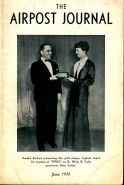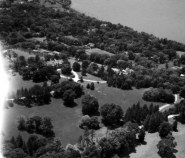Owner Biography
Philip G Cole
According to the Gilcrease Museum's website, Dr. Cole was born in Jacksonville, Illinois, on September 25, 1883, the oldest child of Dr. Charles Knox Cole, a native New Yorker, and his wife Harriet Gillette, of Illinois. The Coles settled in Montana, where C.K., as the elder Cole was called, became speaker of the Montana Territorial Senate during the 1888-89 session, the last before Montana entered the union as the forty-first state in 1889.
C.K. was an investor and rancher as well as a physician. He registered the "J-Bar" and the "Reverse CK" brands with the territory, then the state, of Montana. He built the Helena Hotel, later trading it for other properties, and rumor had it that he also inherited some apartment properties in New York City. Whatever the circumstances, C.K. returned to New York in 1900 a successful businessman. There he invested in a small company founded by a German immigrant inventor named George Schrader, who had developed what came to be known as the bicycle tire valve. Schrader's invention was adapted for automobile tires just as the automotive industry was beginning mass production, proving C.K.'s investment providential. He was soon to become sole owner of the company, a development that launched him on a second career and brought immense wealth to the family. In due time this investment would support the creation of Philip Cole's great collection of the art of the American West.
Philip Cole studied at Phillips Andover Academy, graduating with the class of 1902, and then at Princeton, where he graduated in 1906. He completed his medical studies at the Columbia University College of Physicians and Surgeons in 1910 and did post-graduate work at Bellevue and Harlem Hospitals. He interned as house surgeon at the Harlem hospital, specializing in gynecology, and was greatly respected and appreciated for the work he did there. The hospital community gave him a testimonial farewell dinner upon his departure for Helena, Montana, toward the beginning of the First World War.
Still in his early thirties, Cole left his Helena medical practice for service in France as a reserve officer during the war. With the armistice of 1918 he returned to Helena, where he met and married Katherine Pyle, the daughter of a prominent Montana family and a talented sculptor in her own right. As a wedding gift, C.K. Cole presented the couple with the large Charles Russell canvas of 1910, The Buffalo Hunt. This painting had previously hung in the elder Cole's suite at the Waldorf Hotel in New York City.
With the end of the war, young Cole was confronted by a monumental career decision. His father was by then the principal owner of A. Schrader & Son Inc. of Brooklyn, New York. The manufacturing of automotive parts, valves, and gauges, anchored by the mass-produced tire valve, had mushroomed with the age of the automobile and C.K. wanted his son to take over management of the company. Cole was at a crossroads. He was forced to choose between his medical career in the Montana that he loved and life as an industrialist in New York City. He chose to return to New York. With the death of this father shortly thereafter, Philip became president of A. Schrader & Son. Although he returned to his home state whenever he could, his dream of owning his own Montana ranch never materialized. Instead, he transformed his homes in the East to reflect western themes, and filled them with the art of the West, which eventually lined the walls and filled the bookshelves of several galleries.
He even created a replica of a Montana ranch at his summer residence at Lake Placid, New York, naming it Last Chance Ranch after Last Chance Gulch, the original name for Helena, Montana, and the spot where a group of Georgians discovered gold in 1864. He stocked this New York ranch with young antelope flown in from Montana and reindeer from Alaska that arrived accompanied by an Inuit herder.
In the fall of 1928 Cole purchased the former Whitney estate and home, Zeeview, which included twenty acres of land at Irvington-on-Hudson just below Tarrytown, New York. The family moved in early the following year. The manor house at Zeeview sat comfortably astride the brow of a bluff overlooking the broad Hudson River and the "Tappan Zee." Spacious hallways linked the more than twenty rooms. Zeeview would become Cole's own private museum.
Although Zeeview was visited by Cole's valued friends and by celebrities, including Nancy Russell, Will Rogers, and Olaf Seltzer, for extended periods of time, it was never a rendezvous for the rich and famous. For the most part Zeeview was a sanctuary for the very private Cole, his family, and his beloved art. Consequently, few people were aware of the scale and importance of the American western collection housed there.
Dr. Cole's stamp collection was sold by the auctioneer/dealer F.W. Kessler as part of his airmail collection, in 1939.
C.K. was an investor and rancher as well as a physician. He registered the "J-Bar" and the "Reverse CK" brands with the territory, then the state, of Montana. He built the Helena Hotel, later trading it for other properties, and rumor had it that he also inherited some apartment properties in New York City. Whatever the circumstances, C.K. returned to New York in 1900 a successful businessman. There he invested in a small company founded by a German immigrant inventor named George Schrader, who had developed what came to be known as the bicycle tire valve. Schrader's invention was adapted for automobile tires just as the automotive industry was beginning mass production, proving C.K.'s investment providential. He was soon to become sole owner of the company, a development that launched him on a second career and brought immense wealth to the family. In due time this investment would support the creation of Philip Cole's great collection of the art of the American West.
Philip Cole studied at Phillips Andover Academy, graduating with the class of 1902, and then at Princeton, where he graduated in 1906. He completed his medical studies at the Columbia University College of Physicians and Surgeons in 1910 and did post-graduate work at Bellevue and Harlem Hospitals. He interned as house surgeon at the Harlem hospital, specializing in gynecology, and was greatly respected and appreciated for the work he did there. The hospital community gave him a testimonial farewell dinner upon his departure for Helena, Montana, toward the beginning of the First World War.
Still in his early thirties, Cole left his Helena medical practice for service in France as a reserve officer during the war. With the armistice of 1918 he returned to Helena, where he met and married Katherine Pyle, the daughter of a prominent Montana family and a talented sculptor in her own right. As a wedding gift, C.K. Cole presented the couple with the large Charles Russell canvas of 1910, The Buffalo Hunt. This painting had previously hung in the elder Cole's suite at the Waldorf Hotel in New York City.
With the end of the war, young Cole was confronted by a monumental career decision. His father was by then the principal owner of A. Schrader & Son Inc. of Brooklyn, New York. The manufacturing of automotive parts, valves, and gauges, anchored by the mass-produced tire valve, had mushroomed with the age of the automobile and C.K. wanted his son to take over management of the company. Cole was at a crossroads. He was forced to choose between his medical career in the Montana that he loved and life as an industrialist in New York City. He chose to return to New York. With the death of this father shortly thereafter, Philip became president of A. Schrader & Son. Although he returned to his home state whenever he could, his dream of owning his own Montana ranch never materialized. Instead, he transformed his homes in the East to reflect western themes, and filled them with the art of the West, which eventually lined the walls and filled the bookshelves of several galleries.
He even created a replica of a Montana ranch at his summer residence at Lake Placid, New York, naming it Last Chance Ranch after Last Chance Gulch, the original name for Helena, Montana, and the spot where a group of Georgians discovered gold in 1864. He stocked this New York ranch with young antelope flown in from Montana and reindeer from Alaska that arrived accompanied by an Inuit herder.
In the fall of 1928 Cole purchased the former Whitney estate and home, Zeeview, which included twenty acres of land at Irvington-on-Hudson just below Tarrytown, New York. The family moved in early the following year. The manor house at Zeeview sat comfortably astride the brow of a bluff overlooking the broad Hudson River and the "Tappan Zee." Spacious hallways linked the more than twenty rooms. Zeeview would become Cole's own private museum.
Although Zeeview was visited by Cole's valued friends and by celebrities, including Nancy Russell, Will Rogers, and Olaf Seltzer, for extended periods of time, it was never a rendezvous for the rich and famous. For the most part Zeeview was a sanctuary for the very private Cole, his family, and his beloved art. Consequently, few people were aware of the scale and importance of the American western collection housed there.
Dr. Cole's stamp collection was sold by the auctioneer/dealer F.W. Kessler as part of his airmail collection, in 1939.



